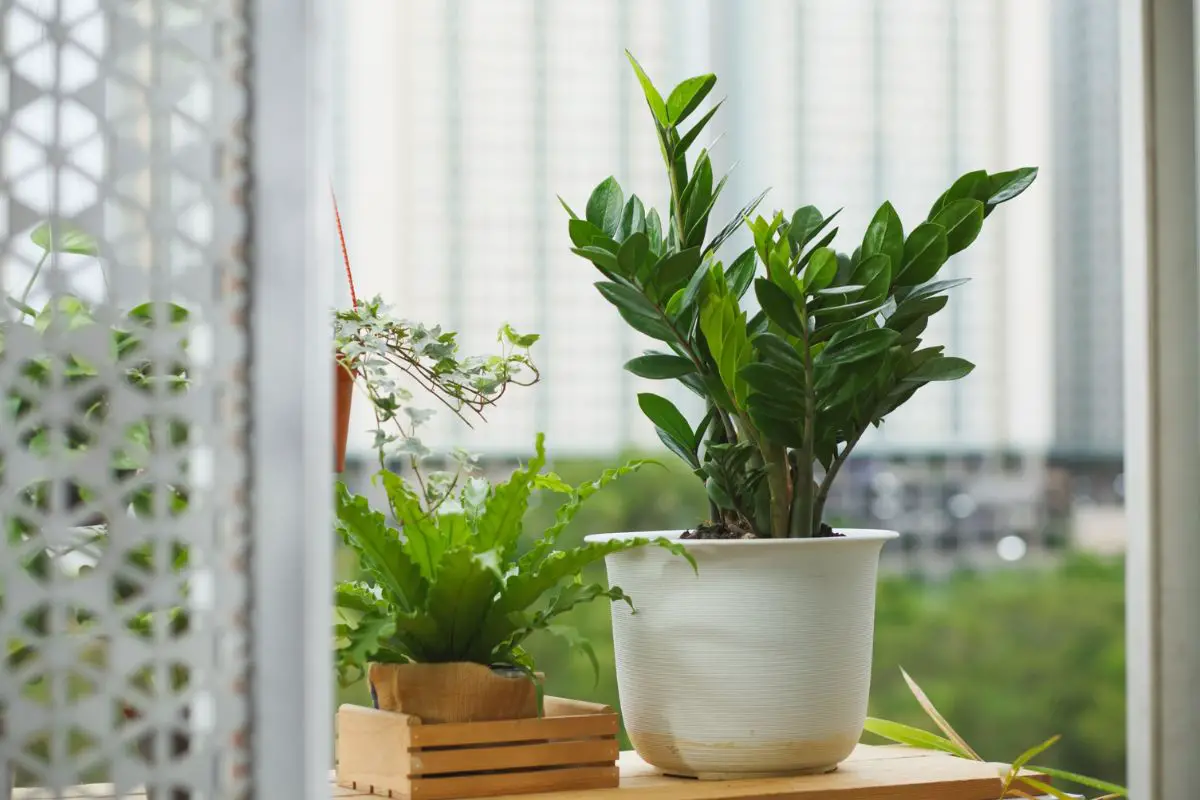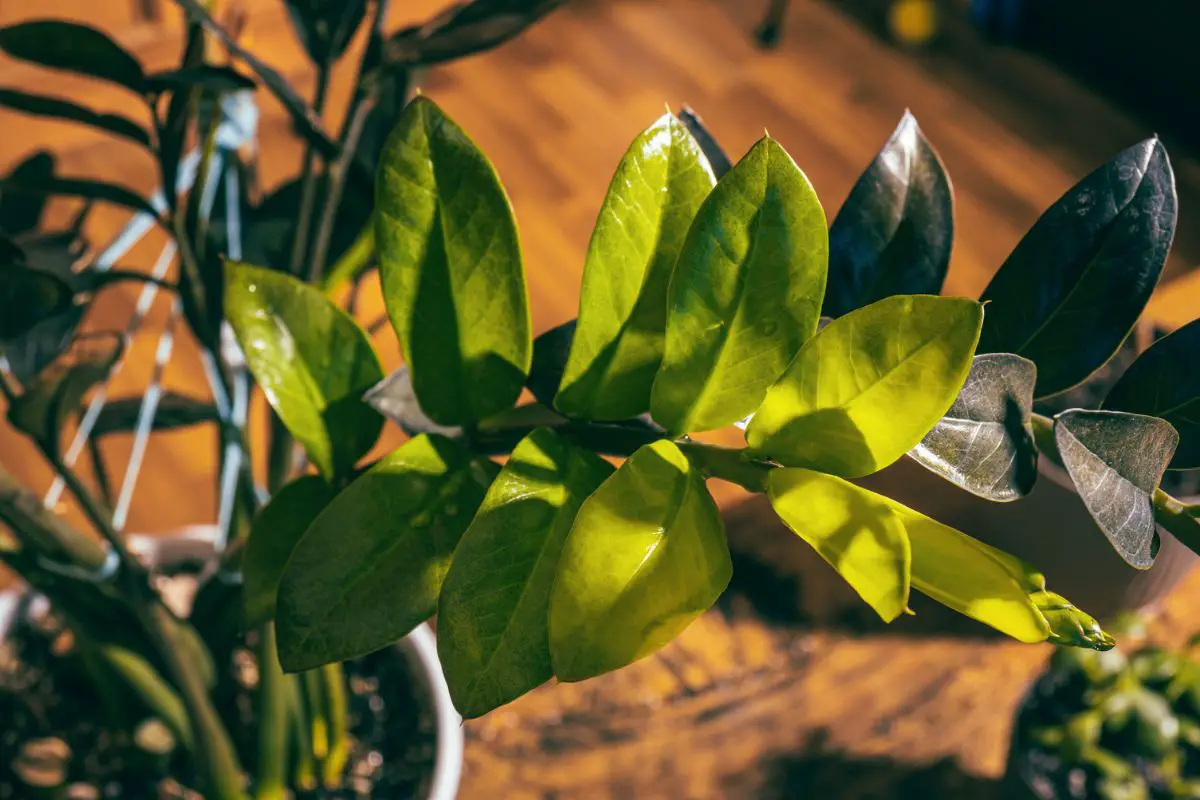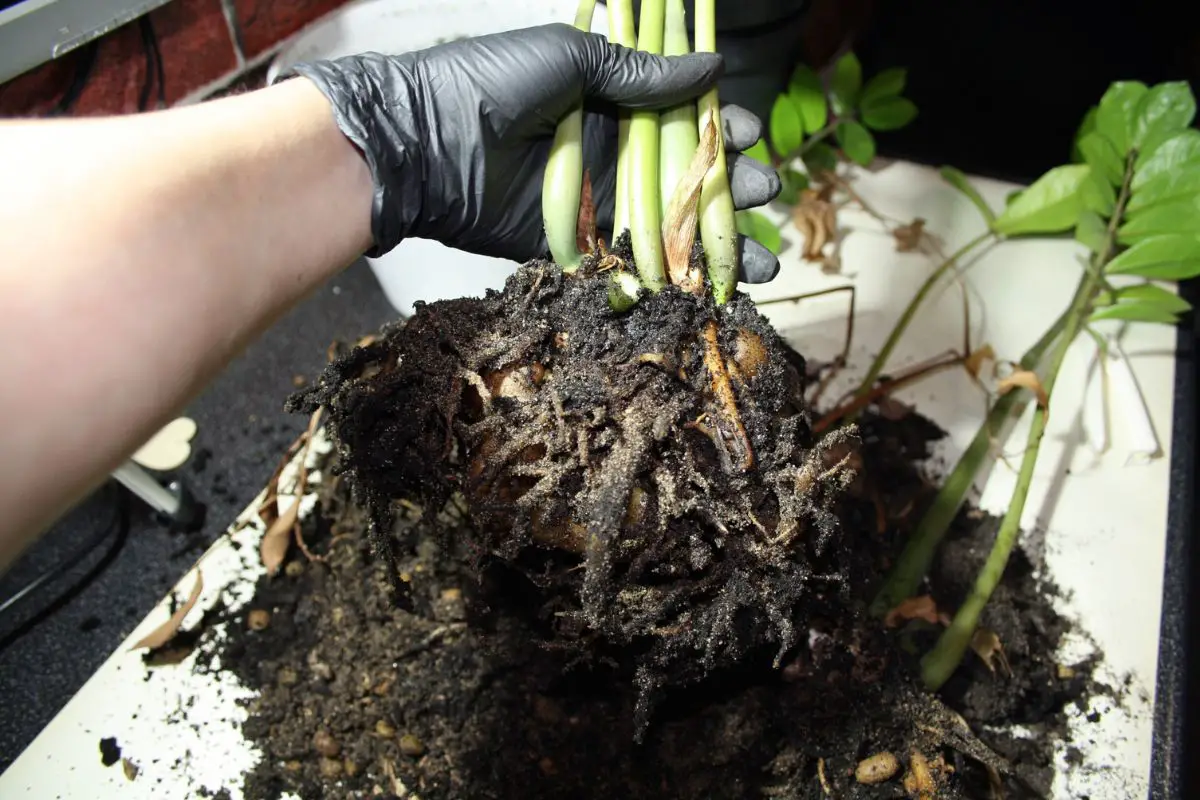Indoor plants have become increasingly popular not just for their aesthetic value but also for the various health benefits they offer to our living spaces. However, it’s not uncommon for plant owners to be concerned when they notice their favorite indoor plants behaving strangely, such as dripping water from their leaves. So, what does this behavior signify when it comes to indoor plants?
When your indoor plants drip water from their leaves, it typically indicates one of three processes: transpiration, guttation, or condensation.
This article will delve deeper into these processes, exploring their distinctions, discussing their implications for your plants, and addressing the question of whether you can intervene when the dripping becomes excessive.
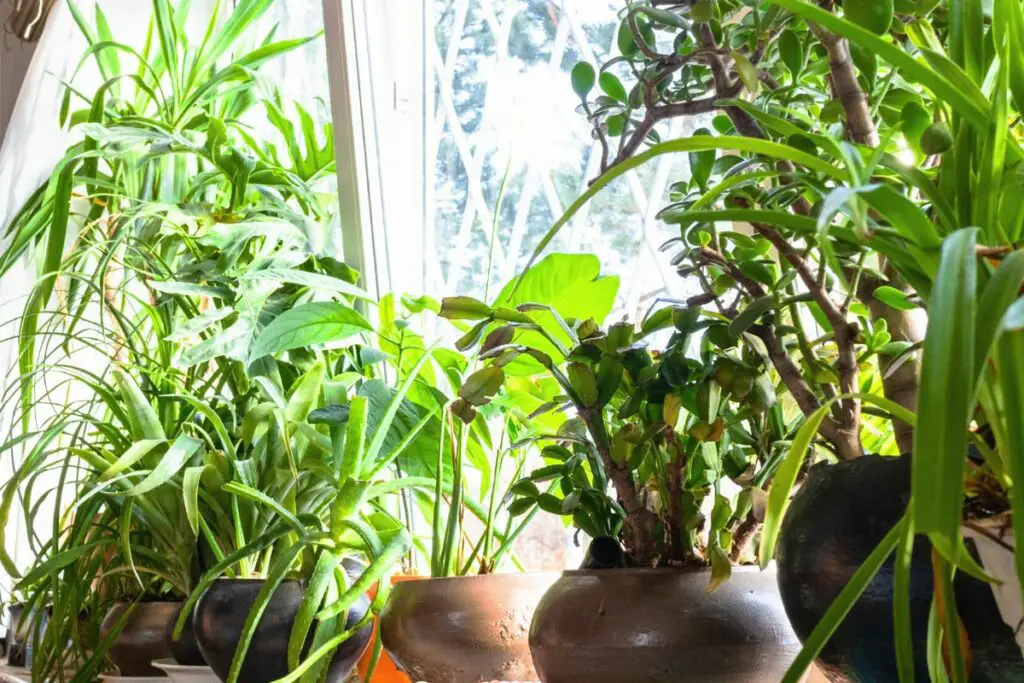
Unpacking the Causes
The two main processes that cause indoor plants to drip water from leaves include transpiration and guttation.
While both processes are essential in their ways, it’s important to know the difference between them to understand why your plant is dripping water from its leaves.
While transpiration and guttation are the most common reasons for water dripping from the leaves, condensation could be another factor causing dripping water.
So, let’s look at the three processes in more detail.
Transpiration: The Invisible Release of Water Vapor
Transpiration involves the evaporation of water from the surface of the leaf. This process mainly occurs through the stomata, or in other words, the leaves’ pores. These “pores” act as a way for plants to breathe. They’re also critical to photosynthesis and the regulation of moisture in the plant.
During transpiration, water is pulled through the plant, released through the stomata, and evaporated into the air. When you water your plant, the roots absorb water from the soil, and the process repeats.
Additionally, the rate at which transpiration happens depends on various factors. Most of the time, you won’t see the water released by the leaves during transpiration because it comes out as vapor (or gaseous form).
However, there are rare instances when you can see the actual water droplets. This sometimes happens when the leaves have absorbed water but the transpiration and evaporation rates have declined and the stomata are partially closed, especially at night. The water remains in liquid form until the temperatures rise high enough and the evaporation rate picks up to turn the liquid into vapor.
The factors that influence the rate of transpiration may include:
- Humidity
- Temperature
- Weather conditions
- Sunlight
- Type of soil
- Precipitation
Humidity is a significant, influential factor, as the more humid the air is, the more the plant will “sweat,” causing more water droplets to appear on your plant’s leaves.
It’s important to note that all plants go through the process of transpiration, even when you can’t see it. However, not all plants experience guttation, which I’ll discuss more in-depth in the next section.
Is Transpiration a Good Thing?
Transpiration is a good thing. It is a sign that water is successfully moving throughout the plant and, therefore, maintaining a healthy plant water balance. Without transpiration, plants wouldn’t be able to release excess water. Consequently, it would wilt and die.
However, while transpiration is essential to plant health, too much can cause dehydration. Therefore, if your indoor plant is excessively transpiring, you must keep a close eye on its water intake. Excessive transpiration without the proper water intake can completely dehydrate the plant.
Guttation: The Unique Process of Water Release
The process of guttation is very similar to transpiration. However, with guttation, the plant’s anatomy includes hydathodes, which only occur in vascular plants. Hydathodes are also pores, but you’ll find them on the edge of the leaves rather than on the surface.
It’s essential to remember that the process of guttation can only occur when there’s pressure in the roots that forces that water out of the leaves. Therefore, large vascular plants can’t experience guttation, only smaller ones.
Some indoor plants that frequently go through the process of guttation include:
- Kalanchoe
- Monstera
- Philodendron
- Ficus
- ZZ Plant
Guttation also appears in a uniformly spaced pattern around the leaf. Therefore, it’s easy to spot the difference between it and transpiration.
What Does Guttation Mean to a Plant?
Although guttation and transpiration are similar in many ways, they have their essential differences.
Guttation is a sign that your plant is in good health. Like with transpiration, guttation releases excess water in the plant, showing that your plant has a working response against overwatering.
However, too much guttation can be a sign of chronic overwatering. If you notice your indoor plants dripping water from leaves due to guttation and see other signs of overwatering, such as yellow leaves and wet soil, this might be a sign to water the plant less.
You also need to check your soil quality if there’s a significant decline in drainage capacity. If that’s the case, you may need to repot your houseplant in better soil.
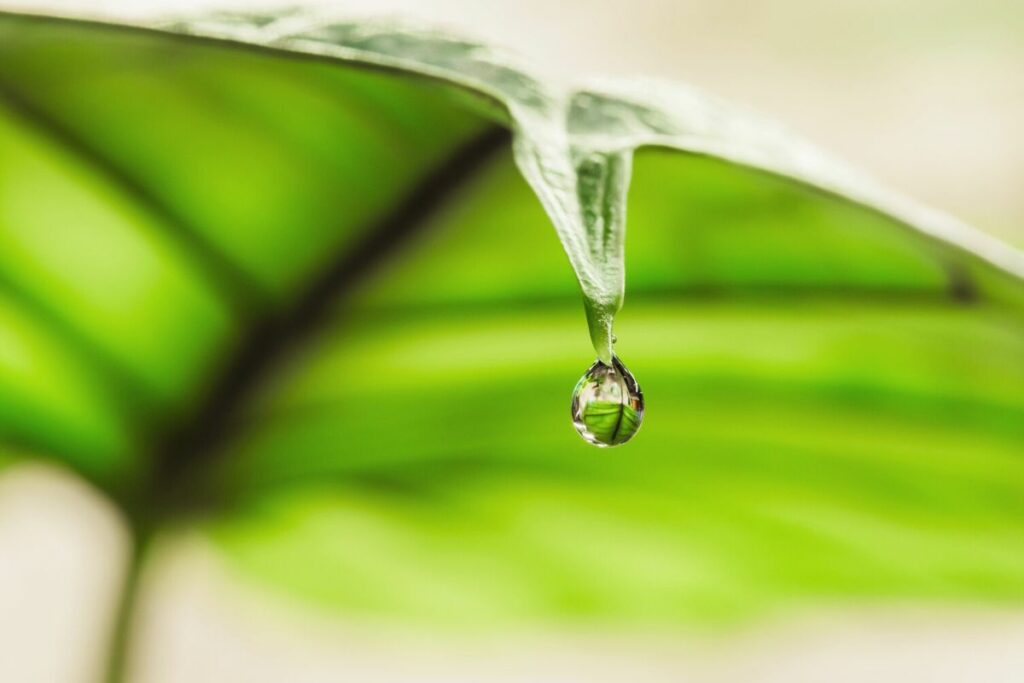
Condensation: Dew on Plant Leaves
Another possible reason your plant is dripping water from leaves is the process of condensation, otherwise known as “dew.” Dew is a common occurrence in all plants, especially in humid climates.
Condensation occurs when humid air comes into contact with a cold surface, turning water vapor into liquid form. One of the most common examples of condensation, or dew formation, is when your grass is wet in the morning.
While many people may not think indoor plants can collect dew on their leaves, it is possible in cool and humid environments or when the plant is under stress.
Therefore, if your environment is cool and humid and your indoor plant is dripping water from its leaves, this could be the reason.
Do Plants Benefit From Dew?
Unlike transpiration and guttation, dew forms due to environmental conditions, including high humidity and low temperatures.
Plants do benefit from dew, especially plants that lack moisture. However, dew can negatively affect plants that receive more than enough moisture, as it can possibly lead to fungal growth and leaf spots.
Can You Prevent Dripping Leaves?
If you find indoor plants dripping water from their leaves and wish to mitigate this occurrence, it’s important to understand that this behavior is generally a sign of plant health. However, if you desire to reduce the extent of water dripping, you can take the following steps:
Optimal Environment
Maintain suitable indoor conditions, including temperature, humidity, and lighting, to ensure your plant operates under ideal circumstances.
Watering Management and Root Rot
If there is a more severe issue with the plant, such as overwatering, root rot, or something else, you must deal with these issues, as it could be a reason for excessive water loss through the leaves.
For minor overwatering problems without root rot, you can fix them by reducing your watering frequency. Wait until the soil is dry enough before watering your plant again.
On the other hand, plants with signs of root rot will need the damaged root sections pruned. Repot the plant in fresh, well-draining potting mix in a new pot.
Drip Tray
If your plant seems healthy but still drips water from its leaves more than you would like, consider placing a drip tray below the pot. Ensure that it’s wide enough to cover the size of the foliage.
Although drip trays mainly serve to hold the water that spills through the bottom of the pot, they’ll work to catch any extra drips from the plant’s leaves that extend beyond the corners of the pot.
Common Related Questions and Answers
Addressing Excessive Dripping: When Should You Take Action?
Although it is common for indoor plants to drip water from their leaves, excessive dripping may be a cause for concern.
If you notice that your plant is showing signs of overwatering, such as wilting or yellowing leaves, it is crucial that you investigate the issue further. You should assess the plant’s overall health, address any underlying problems such as root rot, and make any necessary adjustments to your watering practices.
Can You Stop Your Indoor Plants From Dripping Water From Leaves?
You can’t stop your indoor plants from dripping water from leaves. Your plant dripping water from its leaves is a sign that it’s in good health. However, you can reduce the amount of water dripping by watering your plant less frequently and ensuring the indoor humidity, light, and temperatures are optimal.
So, unless your plant is dripping a significant amount of water from its leaves or other signs pointing to an unhealthy plant, it’s not something that should cause concern.
What Causes Plants to “Sweat”?
Transpiration is a normal plant process that should not release liquid water on the plant’s leaves. Evaporation turns water molecules into vapor under normal conditions. However, if your plant is “sweating”, it could be due to the following reasons:
- Transpiration: Transpiration is a natural plant process where water evaporates from the leaves, turning into vapor under typical conditions. This process should not result in liquid water on the plant’s leaves. It is a normal part of a plant’s life cycle.
- Guttation: If you find that the soil remains wet for several days after watering, and your plant appears to be “sweating” at night, this is likely a case of guttation. Guttation occurs when excess moisture in the soil is pushed up through the plant and excreted as droplets from special glands, typically found at the leaf edges. It is often a sign of overwatering and needs immediate attention to prevent potential issues.
- Dew or Condensation: If you observe your plant dripping water only in the morning, it is most likely due to dew or condensation. In this case, the plant itself is not releasing water; rather, the water molecules in the surrounding air condense on the leaf’s surface as temperatures drop during the night. This is a natural occurrence and does not necessarily require intervention.
Final Thoughts
When indoor plants drip water from leaves, it’s most likely due to either transpiration or guttation, which helps plants remove excess water through the leaf’s “pores.” Both of these processes are entirely healthy and normal for plants to do.
You can reduce the amount of moisture dripping from the leaves by keeping the plant in optimum temperature, humidity, and light conditions. However, excessive guttation from overwatering can signify more severe conditions like root rot that may require you to repot your plant.
Plant leaves can also drip water due to condensation, also known as “dew.” You commonly find dew in cool and humid environments, so if you expose a plant to high humidity, it could explain why your plant is dripping.

